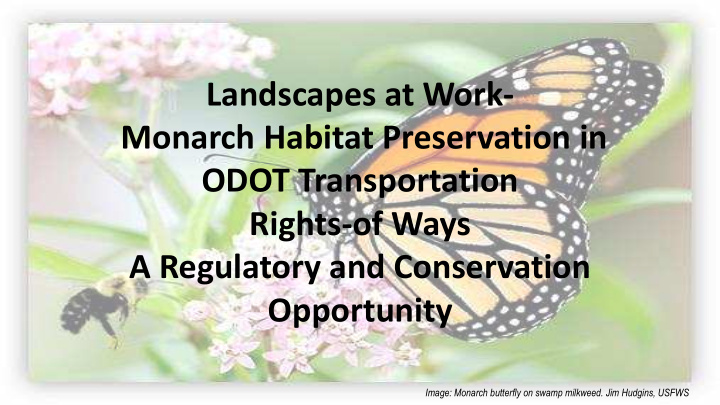



Landscapes at Work- Monarch Habitat Preservation in ODOT Transportation Rights-of Ways A Regulatory and Conservation Opportunity Image: Monarch butterfly on swamp milkweed. Jim Hudgins, USFWS
Threats to Monarch Populations Monarchs face many risks that are resulting in declining populations in both the eastern and western parts of their North American range. The largest impacts come from the loss of habitat, pesticides use, climate change, and risks from natural enemies, such as predators, parasitoids, and diseases. In 2014, the USFWS was petitioned to protect the monarch butterfly under the Endangered Species Act. Based on information in the petition, it was determined that federally protecting the monarch may be warranted. The Service has completed a thorough assessment to determine if the monarch butterfly needs Endangered Species Act protection and a final determination will be announced in December 0f 2020.
What Activities Could Be Impacted By a Listing? General Operations Vehicle operation, maintenance of access routes, installation and maintenance of construction routes and temporary matting. Routine line inspection (aerial and ground patrols), surveying and Survey and Inspections staking, exploratory soil boring Vegetation management activities conducted as part of Vegetation Management as part conservation measure implementation. See list of conservation of Conservation Measures measures for descriptions. Vegetation Management that Vegetation management activities not conducted as part of conservation measure implementation. These activities are may Impact Habitat associated with routine vegetation management actions that may include mowing during the growing season, broadcast herbicide use, and other vegetation management not directly tied to conservation. Minor Structural Maintenance Guy wire replacement, culvert replacement, pole wrapping or painting, structural testing and treatments, structural replacements (insulators, bolts, braces, clamps, grounding wires, and other hardware). Facilities Management and Routine vegetation maintenance of developed lands. General facilities building and maintenance within developed areas. Maintenance Construction within Existing Construction and ground disturbance in existing ROW. ROW Unplanned access and work activities within suitable habitat to Emergency Response Activities resolve emergency response and outage repair needs.
What is a CCAA? Candidate Conservation Agreement with Assurances (CCAA): • A voluntary agreement • Address concerns for species that may be listed in the future • Must provide net conservation benefit • Address all key “manageable” threats under the owners’ control • Gives assurances that USFWS will not request additional conservation measures or restrictions if the species is listed
How Does This Process Work? Authorization of CCAA Certificate of Inclusion Implementation Reporting Enrollment • The Programmatic • USFWS authorizes the • Partners implement • The Programmatic Administrator enrolls agreement and issues conservation Administrator gathers partners into the an Enhancement of measures and conduct and cumulatively agreement terms via Survival Permit for the tracking and reports on agreement Certificates of Monarch. effectiveness compliance to USFWS . Inclusion. monitoring. • The Programmatic • Partners adopt Administrator agrees • Partners annually • USFWS verifies voluntary conservation to uphold the report compliance to compliance and measures, compliance agreement and permit the Programmatic discusses any needs tracking, and compliance Administrator . with Programmatic monitoring required to requirements. Administrator . fulfill the agreement terms.
Assurances Provided By CCAA USFWS provides regulatory assurances authorized by ESA. Once approved, the Service will: • Not require additional conservation measures nor impose additional land, water, or resource use restrictions beyond those voluntarily agreed to and described in the “Conservation Measures” and “Covered Activities” sections of the CCAA. • Review, when needed, assurances tied to the effects of “changed circumstances” and “unforeseen circumstances.”
What Conservation Measures are Available? Select from a menu of conservation measures that address key threats to suitable habitat. Conservation Measure Seeding and planting to restore or create habitat Conservation mowing to enhance floral resource habitat Targeted herbicide treatments Prescribed burning to promote suitable habitat Controlled grazing to promote suitable habitat Brush removal to promote suitable habitat Suitable habitat set-asides (temporary or permanent)
What is Required? • Enroll lands (existing lands and ROW) in the Agreement • Commit to implementing conservation measures • Track implemented conservation measures • Monitor and report results of implemented conservation measures to CCAA Administrator
What is Excluded? • Any activity conducted outside of areas included in Enrolled Lands • Construction projects on new ROW easements or acquired lands • Activities that may pose: Loss of other Federal-listed species, Significant environmental impact, or Controversial projects
Why Pursue this CCAA? Candidate Conservation Agreement with Assurances (CCAA) can help: • Address urgent needs for monarchs • Demonstrate industry commitment to conservation • Address uncertainty from regulatory decisions • Avoid costly delays to projects and provide operational flexibility • Generate positive public recognition • Provide partnership value for all parties (USFWS + industry)
Monarch CCAA Sector Partners Supported by 40+ Industry Partners Representing Cross-Sector Collaboration Arizona Department of Transportation Alliant Energy California Department of Transportation Ameren Colorado Department of Transportation American Electric Power Arizona Department of Transportation ComEd Connexus Energy Delaware Department of Transportation Florida Department of Transportation Cypress Creek Georgia Department of Transportation ComEd Duke Energy Idaho Transportation Department Illinois Department of Transportation Edison Electric Institute Indiana Department of Transportation Evergy Iowa Department of Transportation Exelon Idaho Transportation Department First Energy Maine Department of Transportation Fresh Energy Minnesota Department of Transportation Grow with Trees Nebraska Department of Transportation IVM Partners Nevada Department of Transportation National Rural Electric Coop Association Ohio Department of Transportation NextEra Energy Oklahoma Department of Transportation NiSource Virginia Department of Transportation Pine Gate Renewables Wisconsin Department of Transportation TransCanada MW Association of Fish and Wildlife WEC Energy Group Agencies Federal Highway Administration Federal Railroad Administration
Recommend
More recommend